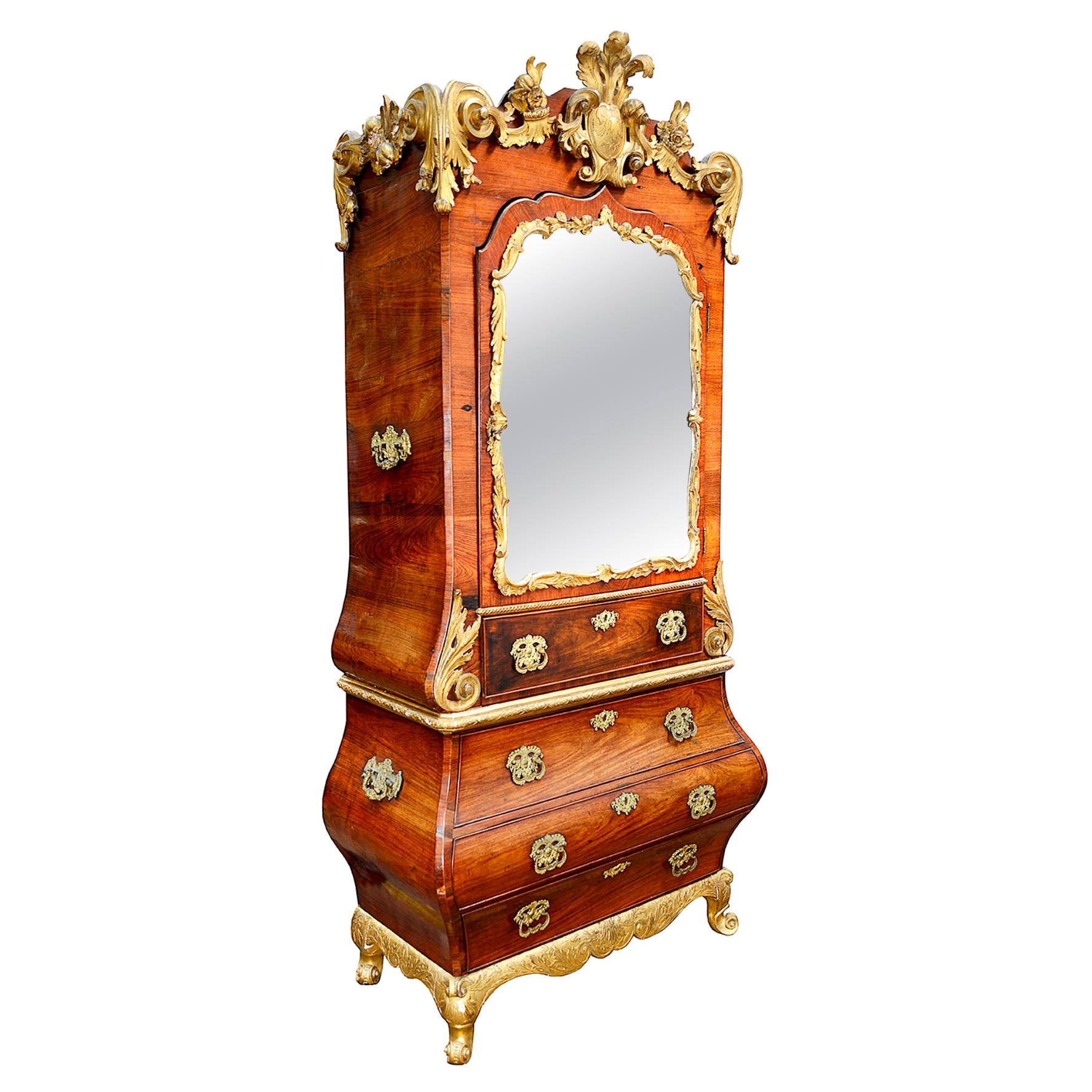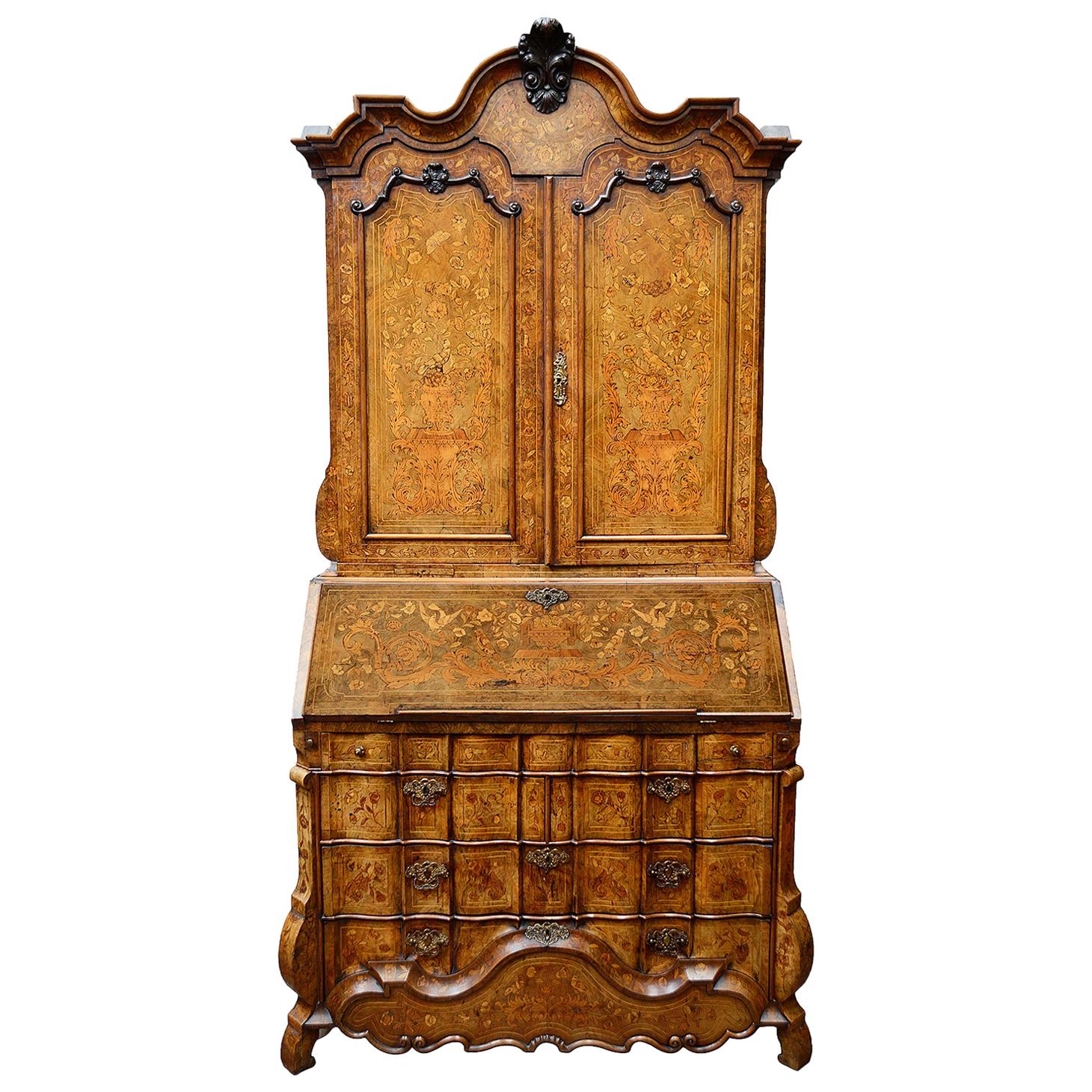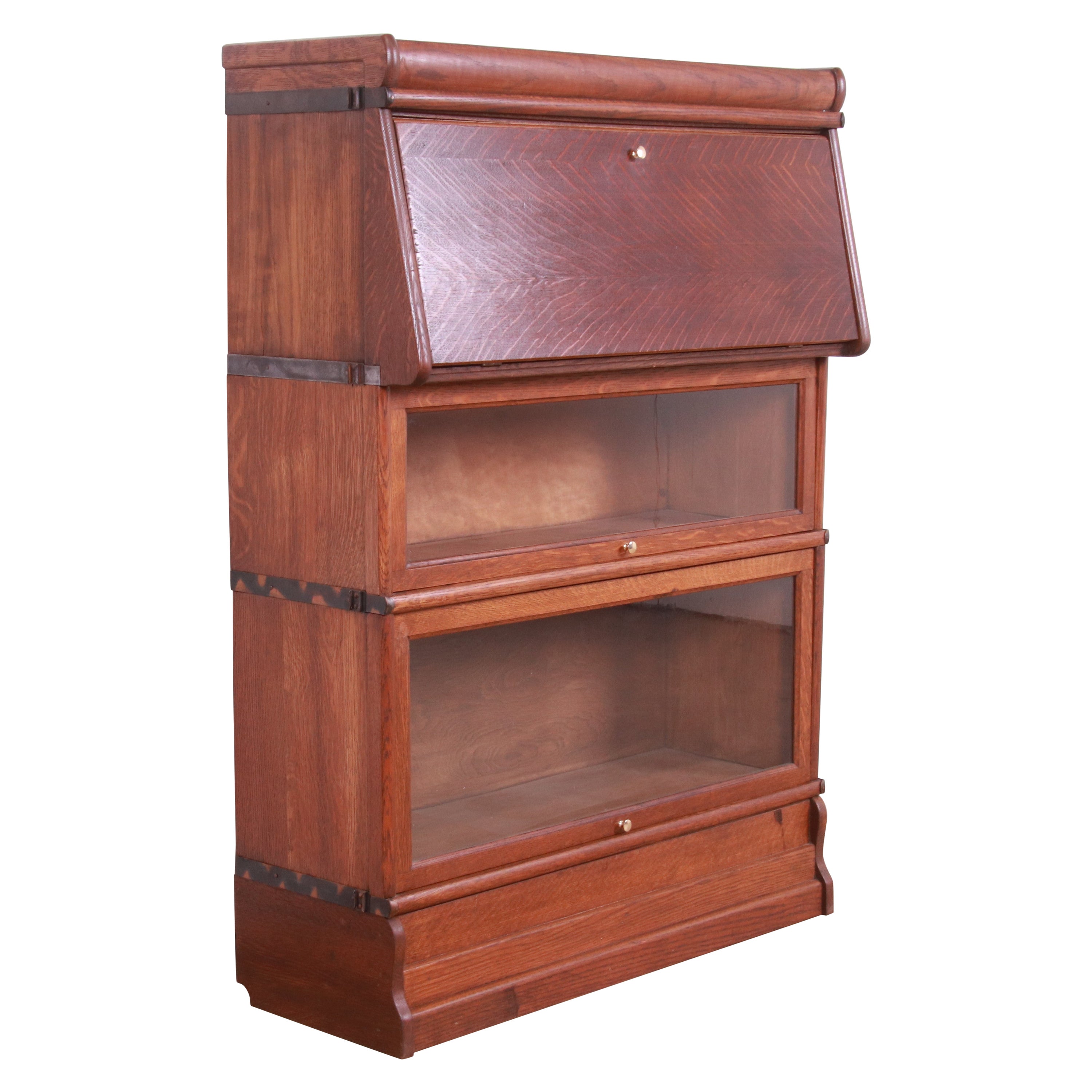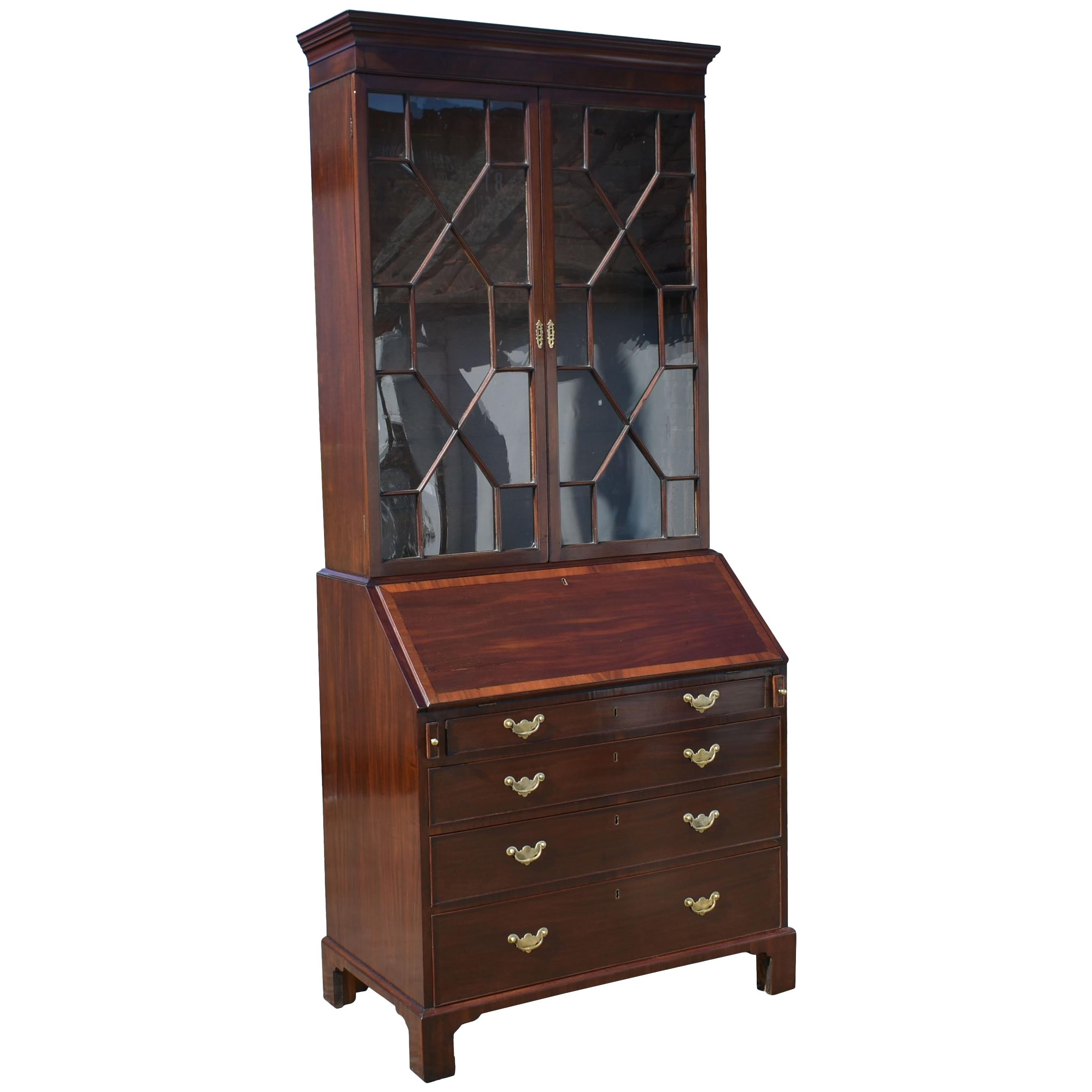Items Similar to Bureau Bookcase Oak German Serpentine Front Original Brassware Working Locks
Want more images or videos?
Request additional images or videos from the seller
1 of 13
Bureau Bookcase Oak German Serpentine Front Original Brassware Working Locks
About the Item
A large, museum quality, 18th century, German, oak bureau bookcase with a serpentine front, original brassware and working locks
As fine an example of this model of German cabinet furniture as can be found, in exceptional original condition
- Characteristically handsome and beautifully made statement piece using the finest quality oak. - - The serpentine front elevates its status into a cabinet piece excluding gravitas.
- The original metalware is exceptional and amazingly intact as are the working locks with original keys. Most likely due to the provenance of having remained in the original schloss, inherited by descent by the male heir.
- In addition to the aesthetic this is a hugely practical piece with masses of storage for papers and writing equipment in the top part and the drawers below.
- In 2 parts
Private collection, my photographs were taken in daylight with an iPad and do not do it any justice.
Measures: Height 219cm., 86 inches
Length 106cm., 41½ inches
Depth 60cm., 23¾ inches.
- Dimensions:Height: 86.23 in (219 cm)Width: 41.74 in (106 cm)Depth: 23.63 in (60 cm)
- Style:Rococo (Of the Period)
- Materials and Techniques:Oak,Joinery
- Place of Origin:
- Period:1740-1749
- Date of Manufacture:circa 1750
- Condition:Wear consistent with age and use.
- Seller Location:BUNGAY, GB
- Reference Number:1stDibs: LU3867320179762
About the Seller
5.0
Vetted Seller
These experienced sellers undergo a comprehensive evaluation by our team of in-house experts.
Established in 1985
1stDibs seller since 2018
85 sales on 1stDibs
Typical response time: 12 hours
- ShippingRetrieving quote...Ships From: BUNGAY, United Kingdom
- Return PolicyA return for this item may be initiated within 7 days of delivery.
More From This SellerView All
- Bookcase Bureau Walnut Burr Original Mirror Plate Bevelled Double Dome FinialsLocated in BUNGAY, SUFFOLKAN EXCEPTIONAL, GEORGE I, BURR WALNUT & FEATHER BANDED, DOUBLE-DOMED BUREAU BOOKCASE WITH ORIGINAL BEVELLED MIRROR PLATES, GILDED FINIALS, FROM THE COLL...Category
Antique 1720s English Baroque Bookcases
MaterialsMirror, Walnut, Giltwood
- Bureau Desk Fall Front Japanning Tortoishell Gilding ChinoiserieLocated in BUNGAY, SUFFOLKA rare, late-17th century / early-18th century, fall front bureau with gilded Chinoiserie Japanning & faux tortoishell ground. “Before Japan was made in England, the imitation of tortoise-shell was much in request for cabinets, tables and the like“. John Stalker and George Parker, a treatise on Japanning and varnishing (originally published in 1668), Alec Tiranti, 1998, p. 75. - This bureau is decorated in one of the most fashionable styles of the Baroque period, Chinese lacquer with gilded decoration and tortoiseshell imitation ground and would have been a statement piece within the interior. - The colours, which have become muted from atmospheric conditions over time, are still striking and colourful evoking warm and richness. - It has come from a private collection where it has reputedly been for many generations which explains why it is in such original condition retaining the original hinges, lock and catches. - Pieces of imitation tortoishell with gilded lacquer decoration are rare, the last piece I handled was a chest of drawers about 20 years ago. - Tortoishell furniture was only affordable by royalty and the elite and the height of fashion in the 17th century, as was producing things that were not what they seemed. One of the oldest examples of faux material from the Baroque period is at Rosenborg Castle in Copenhagen where, in 1667, the royal bed...Category
Antique 17th Century Italian Chinoiserie Desks
MaterialsLacquer
- Bookcase, Glazed, Free-standing, Full-height, Gothic, Oak H271cm 107" L226cm89"Located in BUNGAY, SUFFOLKAN EXCEPTIONAL, LATE GEORGIAN, GOTHIC-REVIVAL BOOKCASE WITH CHARACTERISTIC GOTHIC DETAILING AND STUNNING OAK FIGURING -This is a cabinet piece of extremely high quality, the oak employed has exceptional figuring and medullary rays and it has a lustrous patina and rich mellow color. -It is large but not massive so it would not overpower an interior. -It is in excellent condition and can accommodate a large volume of books. -The lower cupboard section is very useful for storing books or items that need to be concealed. -All the doors have working locks and one key serves the top part and another the bottom. -It is in fabulous original condition This is an exceptional Gothic-Revival bookcase dating from the mid-19th century. It is a cabinet piece of extremely high quality, the oak employed has exceptional figuring and it has a lustrous patina and rich mellow color. It is large but not massive so it would not overpower an interior. It is in excellent condition and can accommodate a large volume of books. The lower cupboard section is very useful for storing books or items that need to be concealed. In three horizontal sections, cornice, upper glazed bookcase and lower cupboard. The upper glazed bookcase in two parts, a right hand side double bookcase and left hand side single. The detachable cornice with an ogee moulding above a deep frieze. The bookcase divided into three sections, each with six panels with original glazing and gothic arches at the top. The interior with numerous fittings for shelves. The doors with original escutcheons, locks and a replaced steel key that operates all the upper bookcase locks. The cupboard section with a 3cm thick top and divided into three sections. The oak doors have beautiful and profuse medullary ray figuring resembling a burr which the cabinet maker has selected to match and Gothic motifs in each corner and at the top of the interposed moulded panels. The interior divided into three enclosed sections each fitted with a single shelf. Original escutcheons, locks and replaced steel key operating all the cupboard base locks. The sides with exceptional medullary ray figuring. On a plinth base. The carcass pine. Twelve Pine Shelves faced with oak reeding...Category
Antique Mid-19th Century British Gothic Revival Bookcases
MaterialsOak
- Bookcase Folding Flat TeakLocated in BUNGAY, SUFFOLKAn unusual and ingenious, mid-century modern retro, portable, folding table top bookcase or display shelf. Slatted supports with three shelves folding flat. Light and easy to carry. Versatile folding mechanism for display, books or bathroom shelves...Category
20th Century French Mid-Century Modern Bookcases
MaterialsTeak
- Cassettone Bureau-Chest Bambocci 16century Italian Renaissance Walnut LombardyLocated in BUNGAY, SUFFOLKAN EXCEPTIONAL MUSEUM QUALITY, ITALIAN, RENAISANCE WALNUT CASSETTONE WITH A FITTED BUREAU IN THE UPPER PART & EXCEPTIONAL BAMBOCCI CARVING, LOMBARDY - This exceptionally rare, museum quality, piece of early furniture was conceived and crafted as an artwork of the finest quality of its time. Throughout time it has been a luxurious, statement piece which has protected it, and fortunately it has survived in virtually, original condition. - This magnificent cassettone exudes the character and quality of the finest, late-Renaissance furniture. Northern Italian Renaissance furniture often had the sides, legs or angles, 'a Bambocci', incorporating carved figures which were considered unique sculptures in their own right. - The putti on this cassettone are beautifully carved and of sculptural quality. Each angel has one arm raised to heaven, a poignant touch. - The lion’s paw feet are a classical feature and make a great statement. - This cassettone was conceived to have visual impact through the quality of the carving, as well as being very practical with the writing compartment fitted in the top part. - It has survived in very original condition with a few small repairs and losses, and the colour and patina are warm and lustrous. - This cassettone is illustrated Illustrated in C. Alberici, Il Mobile Lombardo, Milan, 1969, p. 45, one of the seminal works on Lombardy furniture, and has been in two renowned collections. The hinged top in two sections faced with a solid moulded edge. The front part has a fall front and opens to reveal a writing compartment. The fall front retains its original lock and is concealed with a false drawer which is above three drawers. All with moulded panels, escutcheons and retaining the original iron handles. The front ends have exceptional, bambocci, carved putti raising their arms to heaven above trailing foliage. Standing on magnificent lion's-head carved feet. The sides are panelled. Exceptional original colour and patina. Literature : Illustrated in C. Alberici, Il Mobile Lombardo, Milan, 1969, p. 45. A Gonzalez-Palacois, Il mobile in Liguria, Genova, 1996 illustrates related pieces Measures: Length 147 ½ cm. 58 in, height 104 cm. 41 in, depth 75 cm. 29½ in, Provenance: Coll. Private Azzate The Collection of Sandro and Lidia Orsi, Ca’ Mera, Varese. Regarded as one of the most beautiful homes in Lombardy, Ca’ Mera, the country house of Sandro and Lidia Orsi was filled with beautiful objects from many different epochs. A renowned antiquarian from Milan, over his lifetime Sandro and his wife Lidia revived the Renaissance and Baroque character of the house and instilled their own unique vision into the interiors, which culminated with the creation of a Kunst – or Wunderkammer. “I have never seen such an example of poetical taste”, Sir John Pope...Category
Antique 16th Century Italian Renaissance Commodes and Chests of Drawers
MaterialsWalnut
- Bureau, 19th Century, English, Regency, Mahogany, Secret Drawers, GalleryLocated in BUNGAY, SUFFOLKThe top fitted with a removable gallery with fine brass filigree depicting lion heads and crowns amongst trailing stems. The mahogany, fall-front fitted with a later writing slope, a...Category
Antique Early 19th Century English Regency Desks
MaterialsMahogany
You May Also Like
- Antique English Arts & Crafts Oak Bureau Bookcase Attributed to Liberty & CoBy Liberty & Co.Located in Glasgow, GBAn attractive Arts & Crafts oak motto style bureau bookcase in golden quarter-sawn oak firmly attributed to Liberty & Co. of London. Featuring a moulded carved cornice with inscription ‘J.S. & L.E.S. TO V.R.C. JUNE 7TH 1911’ above a leaded green bullion glass door and open shelves, the bureau fall-front opening to reveal various pigeon holes and a quarter-sawn oak writing surface, with a drawer and pairs of cupboard doors below and three further drawers to the side. With Liberty design shaped hammered copper handles and brass locks to the bureau and drawers. In good solid condition and very well made, this would have been a very special commission as large bureau...Category
Early 20th Century English Arts and Crafts Bookcases
MaterialsBrass, Copper
- 18th Century Scandanvian Rococo Giltwood and Walnut Bureau BookcaseLocated in Brighton, SussexA very impressive 18th Century Rococo carved giltwood and Walnut bureau bookcase, having wonderful scrolling foliate and plume decoration to the cornice, a single mirror door with gi...Category
Antique Late 18th Century Scandinavian Rococo Desks
MaterialsWalnut, Giltwood
- 18th Century Dutch Marquetry Bureau BookcaseLocated in Brighton, SussexA very imposing good quality 18th century Dutch Marquetry bureau bookcase, having wonderful flowers, birds, classical scull and urn decoration. ...Category
Antique 18th Century Dutch Desks
MaterialsWalnut
- Arts & Crafts Oak Barrister Bookcase with Drop Front Secretary Desk, circa 1920sBy Globe WernickeLocated in South Bend, INA gorgeous antique Arts & Crafts barrister bookcase with fall front secretary desk Recently procured from Frank Lloyd Wright's DeRhodes House Attributed to Globe Wernicke US...Category
Vintage 1920s American Arts and Crafts Bookcases
MaterialsBrass
- 19th Century George III Mahogany Bureau BookcaseLocated in Chelmsford, EssexFor sale is a good quality George III mahogany bureau bookcase. Having two glazed doors in the top, both opening to reveal adjustable shelves. Below this is the bureau section, with ...Category
Antique Early 19th Century English George III Bookcases
MaterialsMahogany
- Early 18th Century George I Figured Walnut Bureau BookcaseBy Peter MillerLocated in Oxfordshire, United KingdomA superb and exceptionally well proportioned early 18th century figured walnut ‘pagoda topped’ double dome bureau bookcase, circa 1720 England. The upper section is surmounted with what is believed to be the original solid walnut finials and soft bevelled mirror plates, opening to a removal bank of walnut veneered and feather banded drawers, cantered by pigeonholes below two shelves. Candle slides are neatly stowed below the bookcase doors to reflect the light. To the moulded bureau, the fall opens to reveal pigeonholes, long and short asymmetric drawers each beautifully veneered in figured walnut and feather banded, cantered by a cupboard door which neatly conceals an open compartment and drawer. Below the fall, two short and two long graduating oak lined drawers are each book-matched in superb sections of hand-cut figured walnut veneers over bun feet. It should be noted that this exceptional desk and bookcase, is not only of the finest cuts of figured walnut veneer but exquisitely made at the pinnacle of design which had gradually evolved predominantly in London, during the late 17thand early 18thcentury. The actual description 'desk-and-bookcase' appears to be first recorded in the accounts of the Royal cabinet-maker Gerrit Jensen (fl.1680-d.1715) who supplied several for the Royal Household from 1710 (Bowett, op. cit.), and another described as 'a walnut writing desk, the top for books and patons and glass in the doors asked' for the 5th Earl of Salisbury, Hatfield House. Another maker of this form of desk was the London cabinet-maker John Gumley (1691-1727) who advertised in Richard Steele's Lover on April 24 1714 that he 'hath taken for a Ware-house, and furnished all the upper part of the New Exchange in the Strand' continuing with an extensive list of his stock including 'Desks and Bookcases.' In 1714 he supplied one of these in walnut to James 1st Duke of Montrose for the sum of £11. Russian cabinetwork of this period was strongly influenced by Tsar Peter I return to Russia after his studies in London. He subsequently sent twenty-four cabinetmakers who were working in Amsterdam to London to train as furniture makers. One of these cabinetmakers named Fedor Martynov made furniture for the Empress Anna Ioannovna. Martynovs drawings are almost identical to the present piece. Literature Mallett’s Great English Furniture, London: Bullfinch Press 1991, p.248, fig 287, by Lanto Synge, English Furniture 1660-1714 From Charles II to Queen Anne, by Dr Adam Bowett, Woodbridge: Antique Collector’s Club, 2002 Chapter 7 Case Furniture 1689–1714 pp.221-223 fig. 7:53 A walnut bureau bookcase of the same form and period sold from the private collection of Patricia Kluge...Category
Antique Early 18th Century British George I Bookcases
MaterialsWalnut
Recently Viewed
View AllMore Ways To Browse
Cabinet Locks
Antique Locks
Antique Furniture Locks
Antique Cabinet Locks
Working Desk
Serpentine Front
Working Office Desk
Antique Keys Locks Keys
Antique Locks Locks Keys
Antique Locks Keys
Antique Keys And Locks
Antique Furniture Locks And Keys
Antique Locks With Keys
18th Century German
German Antique Cabinet
German Oak
Germany Oak
Antique Working Desk





